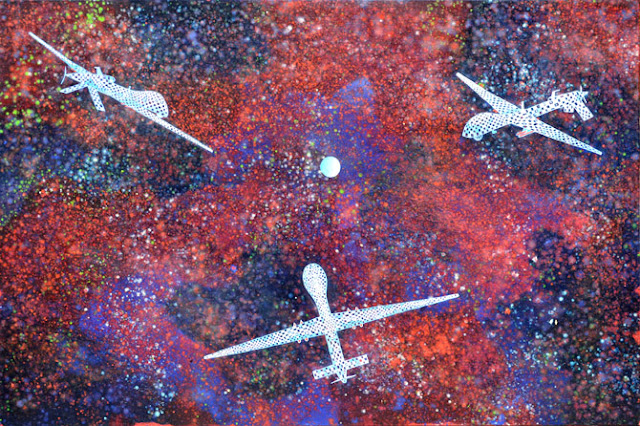Anomaly Detection (Number 2) Oil on linen 120 x 180 cm 2017
The term 'anomaly detection' is a technical one. With contemporary technology and the help of algorithms and artificial intelligence, systems have been devised to detect unusual online behaviours, discrepancies in documentation, weaknesses in cyber systems, and unusual patterns in things like financial transactions and movements of people etc. Anomaly detection enables, in many cases, preemptive action, such as isolating/fixing weaknesses in cyber systems, identifying potentially dangerous activities and malign intent. Anomalies can be detected in image, written and online data that is collected, analysed and stored.
Where did the idea for Anomaly Detection (Number 2) come from?
The idea came after I saw a drone manufacturer's promotional video that demonstrated anomaly detection capabilities of airborne drones. This is where the drone's wide-area electro-optical surveillance systems can cast such a wide net that, for example, three vehicles travelling at speed and many kilometers apart, could be identified as aiming for the same destination. In the case of war and conflict zones this may indicate that the vehicles are aiming for a target, either to destroy it, deliver insurgents to it, or possibly protect a valuable human asset. The latter, of course, in the eyes of those watching may be considered a high value target - HVT.
In Anomaly Detection (Number 2) I have turned the surveillance back onto the drones; in this case three weaponised Grey Eagle drones. I am suggesting that imagination can deploy its own wide-area - even cosmic - surveillance capabilities to question whether technologies designed to detect, monitor, surveil and target, are really beneficial for humanity and the planet. In this painting the three drones seem to be aiming for the same destination - the pale blue dot. Here, I am drawing upon Carl Sagan's term for Earth, as it was seen in the famous photograph, 'Pale Blue Dot', taken in February 1990 by the spacecraft Voyager 1 as it started to leave the solar system. The photograph showed Earth as a small pale blue dot situated within and against our celestial environment. The three drones in Anomaly Detection (Number 2) potentially threaten the pale blue dot.
Anomaly Detection (Number 2) poses a few questions about the vulnerability of humanity and Earth's environment in an age of accelerating technological development. The drones can be seen as literal threats or as metaphors for a society seduced by technology, or exhausted by it. The three drones are painted as if they are pixelated, thus representing their reliance on, and use of, digital and cyber systems. The pixels also suggest a kind of virtual reality, mimicking images seen on computer screens, either those used by drone operators or those used for war games and simulations. There is plenty of room for anomaly detection!
New Sky
The drones are also painted blue to reflect upon the way vertical threat creates a new sky. This is particularly so in places such as Somalia, Yemen, Pakistan and Afghanistan where drone operations and attacks have made people fearful of the sky. In an age where Voyager 1 now travels in interstellar space, the fact that people on Earth are afraid of the sky, is an indictment on humanity.
Dronescape
Anomaly Detection (Number 2) is another of my dronesscapes, but it is also a cosmic landscape provoking and pushing perspective, of all kinds, beyond Earth, even beyond the solar system - and - possibly this universe!
______________________________________

Pale Blue Dot Oil on linen 120 x 160 2014
Anomaly Detection
I recently painted another Anomaly Detection painting [below]. It is a work on paper, depicting three weaponised Reaper drones aiming for the tree-of-life.

Anomaly Detection Gouache on paper 56 x 76 cm 2017
Cheers,
Kathryn

No comments:
Post a Comment